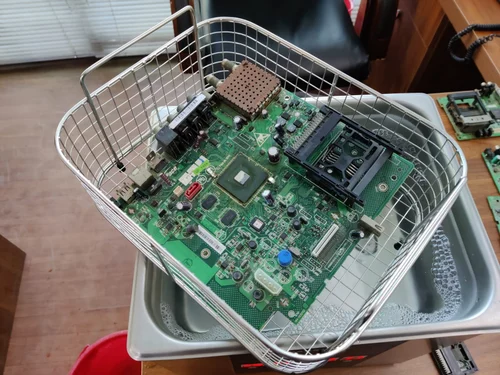Printed Circuit Boards (PCBs) are the backbone of modern electronic devices. From smartphones to sophisticated medical equipment, PCBs are everywhere. However, over time, these essential components can accumulate dirt, dust, and other contaminants that can affect their performance. Enter the ultrasonic PCB cleaning solution. This advanced cleaning method uses ultrasonic waves to clean PCBs efficiently and effectively. In this article, we'll explore what ultrasonic cleaning is, how it works, and why it's the best choice for cleaning PCBs.

Ultrasonic cleaning is a process that uses high-frequency sound waves to create microscopic bubbles in a cleaning solution. These bubbles implode upon contact with the surface of the object being cleaned, effectively removing dirt, grime, and other contaminants. The process is gentle yet thorough, making it ideal for delicate items like PCBs.
An ultrasonic cleaner typically consists of the following components:
Ultrasonic Generator: Produces the high-frequency sound waves.
Transducers: Convert the sound waves into mechanical vibrations.
Cleaning Tank: Holds the cleaning solution and the items to be cleaned.
Cleaning Solution: A liquid medium that enhances the cleaning process.
One of the primary reasons to use ultrasonic cleaning for PCBs is its thoroughness. The microscopic bubbles created during the process can reach even the smallest crevices and tightest spaces on the PCB, ensuring a comprehensive clean that manual methods simply can't achieve.
PCBs are delicate and can be easily damaged by harsh cleaning methods. Ultrasonic cleaning is gentle yet effective, making it the perfect solution for cleaning sensitive electronic components without causing any harm.
Ultrasonic cleaning is also time-efficient. The process typically takes only a few minutes, allowing for quick turnaround times. This is particularly beneficial in industrial settings where time is of the essence.
Many traditional cleaning methods use harsh chemicals that can be harmful to the environment. Ultrasonic cleaning solutions are often biodegradable and environmentally friendly, making them a more sustainable choice.
Prepare the Ultrasonic Cleaner: Fill the cleaning tank with the appropriate cleaning solution. Ensure that the solution is suitable for use with PCBs and is recommended by the manufacturer.
Pre-Clean the PCB: Before placing the PCB in the ultrasonic cleaner, it's a good idea to remove any loose dirt or debris manually. This will enhance the effectiveness of the ultrasonic cleaning process.
Place the PCB in the Cleaning Tank: Carefully place the PCB in the cleaning tank, ensuring that it is fully submerged in the cleaning solution.
Set the Ultrasonic Cleaner: Set the ultrasonic cleaner to the recommended settings for cleaning PCBs. This typically includes adjusting the temperature and duration of the cleaning cycle.
Start the Cleaning Process: Turn on the ultrasonic cleaner and allow it to run for the specified duration. The high-frequency sound waves will create microscopic bubbles that will clean the PCB thoroughly.
Rinse and Dry the PCB: After the cleaning cycle is complete, remove the PCB from the cleaning tank and rinse it with distilled water to remove any residual cleaning solution. Allow the PCB to air dry or use compressed air to speed up the drying process.
When selecting an ultrasonic cleaning solution for PCBs, consider the following factors:
Compatibility: Ensure that the cleaning solution is compatible with PCBs and other electronic components. Some solutions may contain chemicals that can damage sensitive parts.
Effectiveness: Choose a solution that is known for its effectiveness in removing contaminants from PCBs. Look for products with positive reviews and recommendations from industry experts.
Environmental Impact: Opt for environmentally friendly cleaning solutions that are biodegradable and free from harmful chemicals.
Cost: Consider the cost of the cleaning solution and ensure that it fits within your budget. While it's important to invest in a high-quality product, there are also cost-effective options available.
Regular cleaning of PCBs using an ultrasonic cleaner can enhance the performance and longevity of electronic devices. By removing contaminants that can cause malfunctions, ultrasonic cleaning helps ensure that devices operate at their best.
Contaminants like dust, dirt, and residue can cause damage to PCBs over time. Ultrasonic cleaning prevents this damage by thoroughly removing these harmful substances, thereby extending the lifespan of the PCB.
Investing in an ultrasonic cleaner and cleaning solution can be cost-effective in the long run. By maintaining the cleanliness and functionality of PCBs, you can reduce the need for repairs and replacements, saving money over time.
Ultrasonic PCB cleaning solutions offer an efficient, effective, and environmentally friendly way to clean PCBs. The process is thorough yet gentle, making it ideal for delicate electronic components. By investing in an ultrasonic cleaner and the right cleaning solution, you can enhance the performance and longevity of your PCBs, ensuring that your electronic devices operate at their best.
Ultrasonic cleaning is a process that uses high-frequency sound waves to create microscopic bubbles in a cleaning solution. These bubbles implode upon contact with the surface of the object being cleaned, effectively removing dirt, grime, and other contaminants.
An ultrasonic cleaner works by producing high-frequency sound waves that create mechanical vibrations. These vibrations generate microscopic bubbles in the cleaning solution, which implode and remove contaminants from the surface of the object being cleaned.
Ultrasonic cleaning is thorough, gentle, time-efficient, and environmentally friendly. It can reach even the smallest crevices on a PCB, ensuring a comprehensive clean without causing any damage.
When choosing a cleaning solution for PCBs, ensure that it is compatible with electronic components, effective in removing contaminants, environmentally friendly, and cost-effective.
The frequency of cleaning depends on the environment in which the PCBs are used and the level of contamination. Regular cleaning, such as every few months, can help maintain the performance and longevity of the PCBs.